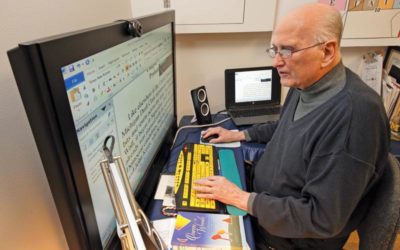The tumors were gone. A month earlier, scientists at the Pfizer laboratories on Plymouth Road had begun dosing mice bearing human tumors with a new kind of cancer drug. Now technicians examining the mice could feel nothing where, days earlier, human colon cancer cells had formed massive lumps. The tumors “just literally melted away,” recalls biochemist Dave Fry. “Our socks were just knocked off. You know, couldn’t believe it.”
Many chemicals will destroy tumors in mice, but only at doses so high that they cripple or kill the host mice. These mice appeared fine. And though it’s much easier to cure cancer in mice than in humans, the impeccable science behind this drug made it especially promising.
The mouse experiments took place in 2001, after six years of grueling work by a team at the massive Parke-Davis pharmaceutical research complex. (Pfizer took over Parke-Davis, and the labs, in 2000.) After making hundreds of compounds and conducting thousands of experiments, chemists under the direction of project co-leader Peter Toogood had synthesized the drug, known internally as PD-0332991.
At the time, Fry and Toogood could not have imagined that it would take more than a dozen years to bring the promising drug to market. (It’s still not quite there.) Pfizer shut down the local labs six years ago. But like an echo that grows louder with time, its products are still making an impact.
Now PD-0332991, which Pfizer recently named palbociclib, is generating excitement again. At a meeting in April, UCLA oncologist Richard Finn reported the results of a clinical trial that enrolled 165 women with metastatic breast cancer. Women who received both palbociclib and letrozole, an older anticancer drug, went a median of 20.2 months with no new tumor growth, compared to 10.2 months for patients taking letrozole plus a placebo pill.
Breast cancer is incurable once it spreads to other organs, and “no study, despite efforts, has shown this dramatic improvement in progression free survival with the addition of a novel agent,” Finn told the meeting. The U.S. Food and Drug Administration has classified palbociclib as a “breakthrough therapy.” Now in final-stage clinical testing for breast cancer at 250 sites around the world, including the U-M, it is also being tested on ovarian, colorectal, liver, prostate, and lung cancers.
—
In 2001, the Nobel Prize in physiology or medicine was awarded to researchers who discovered what the Swedish institute called “key regulators of the cell cycle.” One of those is an enzyme that’s crucial for cell division called cyclin-dependent kinase 4 (Cdk4).
By 1995, the Plymouth Rd. lab–then owned by New Jersey-based Warner-Lambert–was one of several pharmaceutical research centers targeting Cdk4 as a cancer treatment. Tumors grow via runaway cell division, so a drug that blocked it might stop them from growing. Palbociclib, unexpectedly, does far more.
Fry and Toogood, the co-leaders of the Cdk4 project, were at opposite points in their careers. Fry, an Ohio native who earned his PhD in enzymology at OSU, had been at Parke-Davis since 1982, when he was recruited from academia. During his two decades as chief biologist for the company’s cancer program, Fry also developed a lung cancer drug that’s now in late-stage clinical testing, was lead author on an influential paper demonstrating that it’s possible to precisely target tumor defects, and helped pioneer a new approach to drug design.
For Toogood, on the other hand, this was his first project in the drug industry. An amiable Brit from Southampton, he’d arrived in the United States in 1989 to do postdoctoral work at Harvard and later joined the U-M chemistry department. Denied tenure there, he hired on at Parke-Davis and was assigned by chance to the cancer unit. There, he was paired with the older Fry to hunt for a compound that would block Cdk4. “He led the biology, and I led the chemistry,” Toogood recalls. “We worked incredibly well together.”
To develop a new drug, researchers add and subtract chains, rings, and individual atoms from a starter organic molecule. It’s a creative, iterative process that blends science and guesswork about how a change might alter the drug’s behavior. The design possibilities are almost unlimited, and a single tweak can make or break a drug.
Fry credits Toogood’s systematic approach and his technical virtuosity in the chem lab for the team’s success. They were determined not to settle for a compound that was anything less than finely tuned to its enzyme target, Cdk4, thus avoiding most side effects.
At the time, the standard industry approach was to test promising molecules on tumor-bearing mice, a process that took months. The Parke-Davis team developed tests in cells and in mice that enabled them to try and discard compounds in a single day. Only versions that passed this battery of initial tests graduated to mouse trials.
The time saved allowed Toogood’s chemists to quickly rule out dead ends as they gradually learned to build the winning molecule. The 2001 mouse test vindicated their single-minded dedication to finding the “cleanest” drug possible.
While the other companies working on specific Cdk4 inhibitors basically gave up, “we stuck to our guns,” Fry recalls. “We just absolutely refused to … abandon our goal.”
—
Fry and Toogood left Pfizer in 2003 and 2007, respectively, but both have closely followed palbociclib’s progress. “I’m very happy and very proud of it,” says Fry. Knowing the drug works in people “is obviously tremendously exciting,” says Toogood.
One obvious question is why a cancer drug that showed such promise back in 2001 is not yet on the market. That’s a sore point with its inventors. “It’s been an inordinate amount of time for such a great compound,” says Fry, who says that Pfizer “just never gave it the priority.” He calls the neglect “disgusting.”
Dick Leopold, who led the cancer drug discovery program at the Parke-Davis/Pfizer labs from 1989 to 2003, agrees. “I’ve got fairly bitter feelings about how they handled the program,” he says. Leopold blames Pfizer’s rash of drug company acquisitions in the early 2000s, which flooded the pipeline with competing compounds. Organizational disarray followed, and in 2003 Pfizer shut down cancer research at the Ann Arbor site. “It’s my belief that that got in the way of development of the Cdk4 inhibitor,” says Leopold.
Pfizer finally began phase 1 human trials of PD-0332991 in 2004. Phase 2 trials would typically follow in about twelve months. But the company didn’t start phase 2 trials until December 2009.
Pfizer, in a statement, defends the drug’s slow development. “Phase 1 studies with palbociclib in unselected patient populations with different types of cancer did not demonstrate a strong clinical signal of efficacy,” it reads. But Fry blames the company’s habit of doing “very minimal clinical trials.” He says Pfizer could have started the trials sooner and concentrated on cancers where patients were most likely to benefit.
But that’s the only blot, so far, on the palbociclib story. The drug discovered on Plymouth Rd. is finally on the fast track. In May, Pfizer announced that it will soon apply for FDA approval. If granted, the drug could be available to patients next year.
Many key figures in its discovery and early development still live and work in Ann Arbor. Toogood is back in the former Pfizer labs as vice president at the biotech company Lycera, which leases space there from the U-M. Leopold is co-founder and vice president of Molecular Imaging, which does contract research for academic and industry clients at the Avis Farms research complex on S. State. “We are growing,” Leopold says. “I don’t spend a lot of time looking back.”
Fry, on the other hand, reflects often on his exceptional career. After leaving Pfizer, he worked for the local biotech company Genetics Squared (now Everist Genomics) before retiring two years ago. “I’ve had a great career, and I’m content,” he says. “It doesn’t diminish my excitement just because I’m out of the field.
“I mean, when those drugs are approved, I’m going to be celebrating along with everyone else.”




